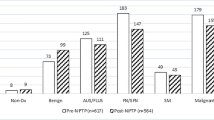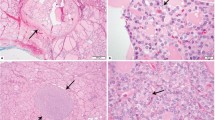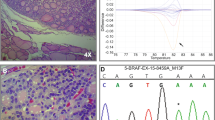Abstract
Background
Renaming encapsulated follicular variant of papillary thyroid carcinoma (EFVPTC) to noninvasive follicular thyroid neoplasm with papillary-like nuclear features (NIFTP) was recently suggested to prevent the overtreatment, cost and stigma associated with this low-risk entity. The purpose of this study is to document the incidence and further assess the clinical outcomes of reclassifying EFVPTC to NIFTP.
Methods
We searched synoptic pathologic reports from a high-volume academic endocrine surgery hospital from 2004 to 2013. The standard of surgical pathology practice was based on complete submission of malignant thyroid nodules along with the nontumorous thyroid parenchyma. Rigid morphological criteria were used for the diagnosis of noninvasive EFVPTC, currently known as NIFTP. A retrospective chart review was conducted looking for evidence of malignant behavior.
Results
One hundred and two patients met the strict inclusion criteria of NIFTP. The incidence of NIFTP in our cohort was 2.1% of papillary thyroid cancer cases during the studied time period. Mean follow-up was 5.7 years (range 0–11). Five patients were identified with nodal metastasis and one patient with distant metastasis. Overall, six patients showed evidence of malignant behavior representing 6% of patients with NIFTP.
Conclusion
Our study demonstrates that the incidence of NIFTP is significantly lower than previously thought. Furthermore, evidence of malignant behavior was seen in a significant number of NIFTP patients. Although the authors fully support the de-escalation of aggressive treatment for low-risk thyroid cancers, NIFTP behaves as a low-risk thyroid cancer rather than a benign entity and ongoing surveillance is warranted.


Similar content being viewed by others
References
Davies L, Welch HG (2014) Current thyroid cancer trends in the United States. JAMA Otolaryngol Head Neck Surg 140:317–322
Canadian Cancer Society’s Advisory Committee on Cancer Statistics (2015) Canadian Cancer Statistics 2015—Special Topic. Canadian Cancer Society
Ahn HS, Kim HJ, Welch HG (2014) Korea’s thyroid-cancer “epidemic”—screening and overdiagnosis. N Engl J Med 371:1765–1767
Lubitz CC, Sosa JA (2016) The changing landscape of papillary thyroid cancer: epidemiology, management, and the implications for patients. Cancer 122:3754–3759
Vaccarella S, Dal Maso L, Laversanne M et al (2015) The impact of diagnostic changes on the rise in thyroid cancer incidence: a population-based study in selected high-resource countries. Thyroid 25:1127–1136
Nikiforov YE, Seethala RR, Tallini G et al (2016) Nomenclature revision for encapsulated follicular variant of papillary thyroid carcinoma: a paradigm shift to reduce overtreatment of indolent tumors. JAMA Oncol 2:1023–1029
Fagin JA, Wells SA Jr (2016) Biologic and clinical perspectives on thyroid cancer. N Engl J Med 375:1054–1067
Jung CK, Little MP, Lubin JH et al (2014) The increase in thyroid cancer incidence during the last four decades is accompanied by a high frequency of BRAF mutations and a sharp increase in RAS mutations. J Clin Endocrinol Metab 99:276
Bychkov A, Hirokawa M, Jung CK, et al (2017) Low rate of noninvasive follicular thyroid neoplasm with papillary-like nuclear features in Asian practice in Asian practice. Thyroid ahead of print
Cho U, Mete O, Kim MH et al (2017) Molecular correlates and rate of lymph node metastasis of non-invasive follicular thyroid neoplasm with papillary-like nuclear features and invasive follicular variant papillary thyroid carcinoma: the impact of rigid criteria to distinguish non-invasive follicular thyroid neoplasm with papillary-like nuclear features. Mod Pathol 30:810–825
Saxen E, Franssila K, Bjarnason O et al (1978) Observer variation in histologic classification of thyroid cancer. Acta Pathologica et Microbiologica Scandinavica—Sect A Pathol 86A:483–486
Elsheikh TM, Asa SL, Chan JK et al (2008) Interobserver and intraobserver variation among experts in the diagnosis of thyroid follicular lesions with borderline nuclear features of papillary carcinoma. Am J Clin Pathol 130:736–744
Lloyd RV, Erickson LA, Casey MB et al (2004) Observer variation in the diagnosis of follicular variant of papillary thyroid carcinoma. Am J Surg Pathol 28:1336–1340
Hirokawa M, Carney JA, Goellner JR et al (2002) Observer variation of encapsulated follicular lesions of the thyroid gland. Am J Surg Pathol 26:1508–1514
Lee SE, Hwang TS, Choi YL et al (2017) Molecular profiling of papillary thyroid carcinoma in Korea with a high prevalence of BRAFV600E mutation. Thyroid 27:802–810
Haugen BR, Sawka AM, Alexander EK et al (2017) American thyroid association guidelines on the management of thyroid nodules and differentiated thyroid cancer task force review and recommendation on the proposed renaming of encapsulated follicular variant papillary thyroid carcinoma without invasion to noninvasive follicular thyroid neoplasm with papillary-like nuclear features. Thyroid 27:481–483
Author information
Authors and Affiliations
Corresponding author
Ethics declarations
Conflict of interest
The authors declare that they have no conflict of interest.
Rights and permissions
About this article
Cite this article
Parente, D.N., Kluijfhout, W.P., Bongers, P.J. et al. Clinical Safety of Renaming Encapsulated Follicular Variant of Papillary Thyroid Carcinoma: Is NIFTP Truly Benign?. World J Surg 42, 321–326 (2018). https://doi.org/10.1007/s00268-017-4182-5
Published:
Issue Date:
DOI: https://doi.org/10.1007/s00268-017-4182-5




